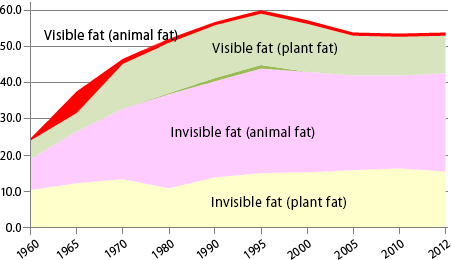Until now, we have introduced the constituents and functions of vegetable oil. As shown in Figure 1, in addition to fats consumed as food products, fats are also contained in ingredients eaten on a daily basis. In actuality, in the daily life of Japanese people, most people eat fats obtained from ingredients that are eaten without much thought. Fats contained in ingredients are called "invisible fats." Conversely, fats that are obtained directly from oils and fats can be confirmed and are therefore called "visible fats." The status of consumption for both types of fats is shown in Figure 2. According to the National Health and Nutrition Survey (FY2019) conducted by the MHLW, the amount of fat consumed per person per day is 61.3 g, 48.3g of which are invisible fats.
Figure 2: Consumption amount of visible fat and invisible fat (average)
(Unit: grams per person per day)

Source: National Health and Nutrition Survey (MHLW), multiple years
Note: The values in Figure 2 were calculated by the JOPA based on the fat consumption amounts listed in the National Health and Nutrition Survey
Although total fat consumption amount had been declining since 1995, it has started rising again in recent years. When examining a breakdown of consumption, "visible oil" has gradually decreased while animal fats in the "invisible oil" category have increased slightly. Based on the misconception that "eating fats will make me fat," people are suppressing their consumption of easily-managed visible oil (salad oil, margarine, butter, mayonnaise, etc.). Conversely, the animal fat consumption amount is increasing due to a rise in consumption of meat. Food made from fatty ingredients and cooked using fats/oils tastes good and is therefore prone to unconscious over-eating. Also, a surprisingly high amount of fat is contained in processed foods and side dishes. It is very difficult to manage fat consumption while considering all of these factors. This has resulted in the trends shown in Figure 2. However, simply reducing consumption of visible fat poses the risk of harming the appropriate ratio for plant fats to animal fats (a ratio of 1:1 is desirable). Instead, when seeking to reduce fat consumption, it may be more appropriate to refrain from consuming animal products or processed products that contain a large amount of fat.




